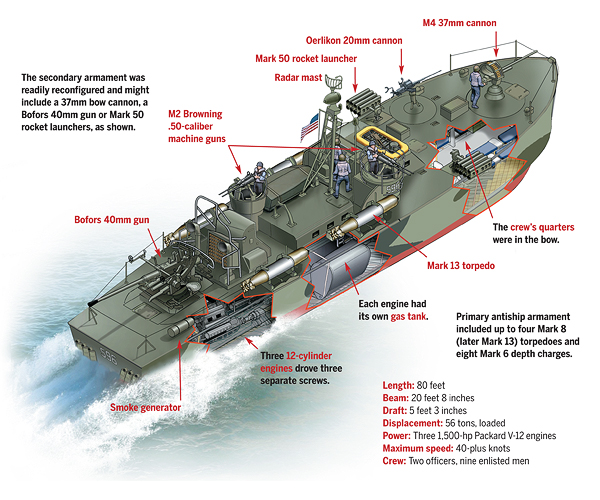When Japan attacked Pearl Harbor in 1941, the United States was thrust into a war that it hadn’t necessarily planned on participating in. America realized very quickly that the Pacific battlefield would be an island-hopping campaign. This would include attacking and harassing supply chains and combatant ships. This mission profile was a perfect fit for the Navy’s new and improved patrol torpedo boat, better known as the PT boat.
Before World War II began, the U.S. Navy had identified the need for a high-speed attack boat. In 1938, the Navy held a competition, looking for different manufacturers to design and build a boat that the Navy could put into service. These competitions were known as the “plywood derbies” and many companies were involved in them. After many rigorous test competitions and sea trials, only a few manufacturers remained. Electric Launch Company (Elco) and Higgins Industries would be the main builders to create the PT boat fleet. A side note, Higgins Industries may be a familiar word to many: Higgins Industries was responsible for the design and construction of the landing crafts used at D-Day and Iwo Jima — theirs was a pivotal design that helped bring WWII to an end.
There were 326 Elco boats built during WWII. These boats measured 80 feet in length and had a 20-foot beam. Their hulls were built out of diagonally laid mahogany planks and held together with copper rivets and bronze screws. This type of construction allowed for easy maintenance and repairs in remote locations of the Pacific. The Elco boats were powered by triple 4M-2500 Packard engines, which delivered 1,500 horsepower apiece, providing a top speed of 41 knots.
Higgins Industries built 199 PT boats. They measured 78 feet long, with a 20-foot beam. The construction techniques, materials, and engines used were very similar to Elco’s PT boat.
Since PT boats were made of wood and had no real armor, the only way to compensate was to install a large array of weapons. PT boats were typically outfitted with four Mark 13 torpedoes, twin .50 and .30 caliber machine guns, 20 mm cannons, and later on 37 mm and 40 mm cannons.
PT boats often operated at night; the cover of darkness was their greatest strength, especially once radar became a standard on all boats. As units, they would lay and wait in darkness until a Japanese ship would become visible on the radar. Once a target was acquired, they would ambush the enemy with torpedoes and cannon fire. Using these tactics, PT boats were deemed extremely successful and lethal during the Solomon Islands and Guadalcanal campaigns. The Japanese indeed feared the PT boat.

An Elco PT boat and its hefty armament (Image courtesy of History.net).
The PT boats’ most noteworthy and deadly capability was being able to attack supply barges in shallow water. This was observed in both the Pacific and European theaters. Enemy barges would travel in shallow water at night, in order to prevent being attacked by large naval vessels. The PT boat proved to be the perfect weapon of choice in taking them out. Oftentimes, enemy barges would be in such shallow water that torpedoes could not be used; in such cases, the PT boats would overwhelm the barges with their large-caliber machine guns and cannons.
The boats had many other mission sets as well. These included search and rescue operations, destroying mines, reconnaissance, providing smokescreens, and insertion/extraction of allied troops. During D-Day, they were used to provide a protective barrier against attacking German S-boats. They also picked up soldiers and sailors that had fallen out of boats and airmen that had been shot down.
These Motor Torpedo Boat Squadrons paid a heavy price in order to complete their missions: 99 out of the 531 boats were lost during the war. Many sailors and Naval officers gave their lives or were wounded while serving as PT crewmen. Two PT boat commanding officers were awarded the Medal of Honor for their actions. PT boats may have been relatively small, but they certainly packed a heavy punch.
Already have an account? Sign In
Two ways to continue to read this article.
Subscribe
$1.99
every 4 weeks
- Unlimited access to all articles
- Support independent journalism
- Ad-free reading experience
Subscribe Now
Recurring Monthly. Cancel Anytime.
Most PT boats were destroyed after WWII. Today, though, there are still several PT boats in museums in order to pay tribute to that time in history and to the crews for what they did for their brethren and the United States.
















